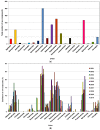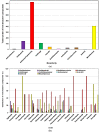Marine sponge derived natural products between 2001 and 2010: trends and opportunities for discovery of bioactives
- PMID: 25196730
- PMCID: PMC4145330
- DOI: 10.3390/md12084539
Marine sponge derived natural products between 2001 and 2010: trends and opportunities for discovery of bioactives
Abstract
Marine sponges belonging to the phylum Porifera (Metazoa), evolutionarily the oldest animals are the single best source of marine natural products. The present review presents a comprehensive overview of the source, taxonomy, country of origin or geographical position, chemical class, and biological activity of sponge-derived new natural products discovered between 2001 and 2010. The data has been analyzed with a view to gaining an outlook on the future trends and opportunities in the search for new compounds and their sources from marine sponges.
Figures









References
-
- Bergmann W., Feeney R.J. Contributions to the study of marine products. XXXII. The nucleosides of sponges I. J. Org. Chem. 1951;16:981–987. doi: 10.1021/jo01146a023. - DOI
-
- Bergmann W., Feeney R.J. The isolation of a new thymine pentoside from sponges 1. J. Am. Chem. Soc. 1950;72:2809–2810. doi: 10.1021/ja01162a543. - DOI
-
- Carte B.K. Biomedical potential of marine natural products. Bioscience. 1996;46:271–287. doi: 10.2307/1312834. - DOI
Publication types
MeSH terms
Substances
LinkOut - more resources
Full Text Sources
Other Literature Sources

